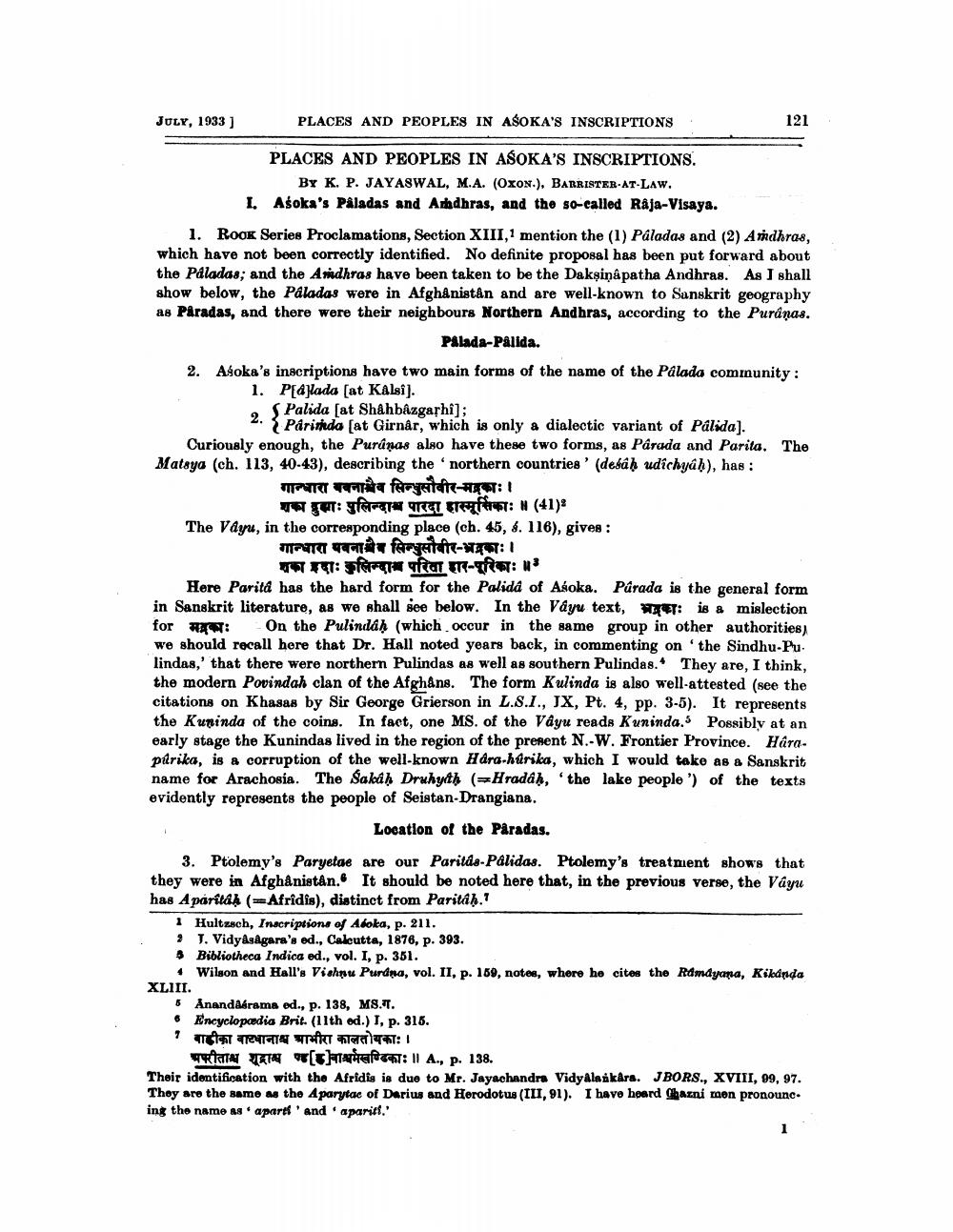________________
JULY, 1933)
PLACES AND PEOPLES IN ASOKA'S INSCRIPTIONS
121
PLACES AND PEOPLES IN ASOKA'S INSCRIPTIONS
BY K. P. JAYASWAL, M.A. (Oxon.), BARRISTER-AT-LAW. I. Asoka's Paladas and Andhras, and the so-called Råja-Visaya. 1. ROOK Series Proclamations, Section XIII, 1 mention the (1) Paladas and (2) Andhras, which have not been correctly identified. No definite proposal has been put forward about the Paladas; and the Andhras have been taken to be the Dakşiņa patha Andhras. As I shall show below, the Paladas were in Afghanistan and are well-known to Sanskrit geography as Paradas, and there were their neighbours Northern Andhras, according to the Puráņas.
Palada-Palida. 2. Asoka's inscriptions have two main forms of the name of the Palada community :
1. P[ajlada (at Kalsi).
SPalida [at Shahbâzgashi];
4. Parishda (at Girnår, which is only a dialectic variant of Pálida). Curiously enough, the Puranas also have these two forms, as Parada and Parita. The Matsya (ch. 113, 40-43), describing the northern countries' (desah udichyah), has :
गान्धारा बनाव सिन्धुसौवीर-मद्रकाः।
Te gat:yfarer RET ETT: N (41) The Vayu, in the corresponding place (ch. 45, 6. 116), gives :
गान्धारा यवनाचैव सिन्धुसौवीर-भद्रकाः।
T: ferrari far-me: * Here Parita has the hard form for the Palida of Asoka. Parada is the general form in Sanskrit literature, as we shall see below. In the Vayu text, Wer: is a mislection for 2 : On the Pulindah (which occur in the same group in other authorities, we should recall here that Dr. Hall noted years back, in commenting on the Sindhu-Pu. lindas,' that there were northern Pulindas as well as southern Pulindas.. They are, I think, the modern Povindah clan of the Afgháns. The form Kulinda is also well-attested (see the citations on Khasas by Sir George Grierson in L.S.I., JX, Pt. 4, pp. 3-5). It represents the Kuninda of the coins. In fact, one MS. of the Vayu reads Kuninda.5 Possibly at an early stage the Kunindas lived in the region of the prenent N.-W. Frontier Province. Hara. pitrika, is a corruption of the well-known Hara-harika, which I would take as a Sanskrit name for Arachosia. The Sakah Druhyth (=Hradáh, the lake people ') of the texts evidently represents the people of Seistan-Drangiana.
Location of the Paradas.
3. Ptolemy's Paryetae are our Paritás-Palidas. Ptolemy's treatment shows that they were in Afghanistan. It should be noted here that, in the previous verse, the Vayrı has A paritsa (=Afridis), distinct from Parita).
1 Hultzsch, Inscriptions of Asoka, p. 211. ; J. Vidyasagara's ed., Calcutta, 1876, p. 393. 4 Bibliotheca Indica ed., vol. I, p. 351.
4 Wilson and Hall's Vishnu Purdna, vol. II, p. 169, notes, where he cites the Ramdyana, Kikinda XLIII
5 Anandabrama ed., p. 138, MS.T. 6 Encyclopaedia Brit. (11th ed.) I, p. 316.
बाडीका वाटयानाश्चाभीरा कालतोयकाः।।
RATTAT 174 [C]reft: ll A., p. 138. Their identification with the Afridis is due to Mr. Jayachandra Vidyalaikära. JBORS., XVIII, 99, 97. They are the same as the Aparytac of Darius and Herodotus (III, 91). I have heard Chazni mon pronounce ing the name as a parti' and 'aparit.'




